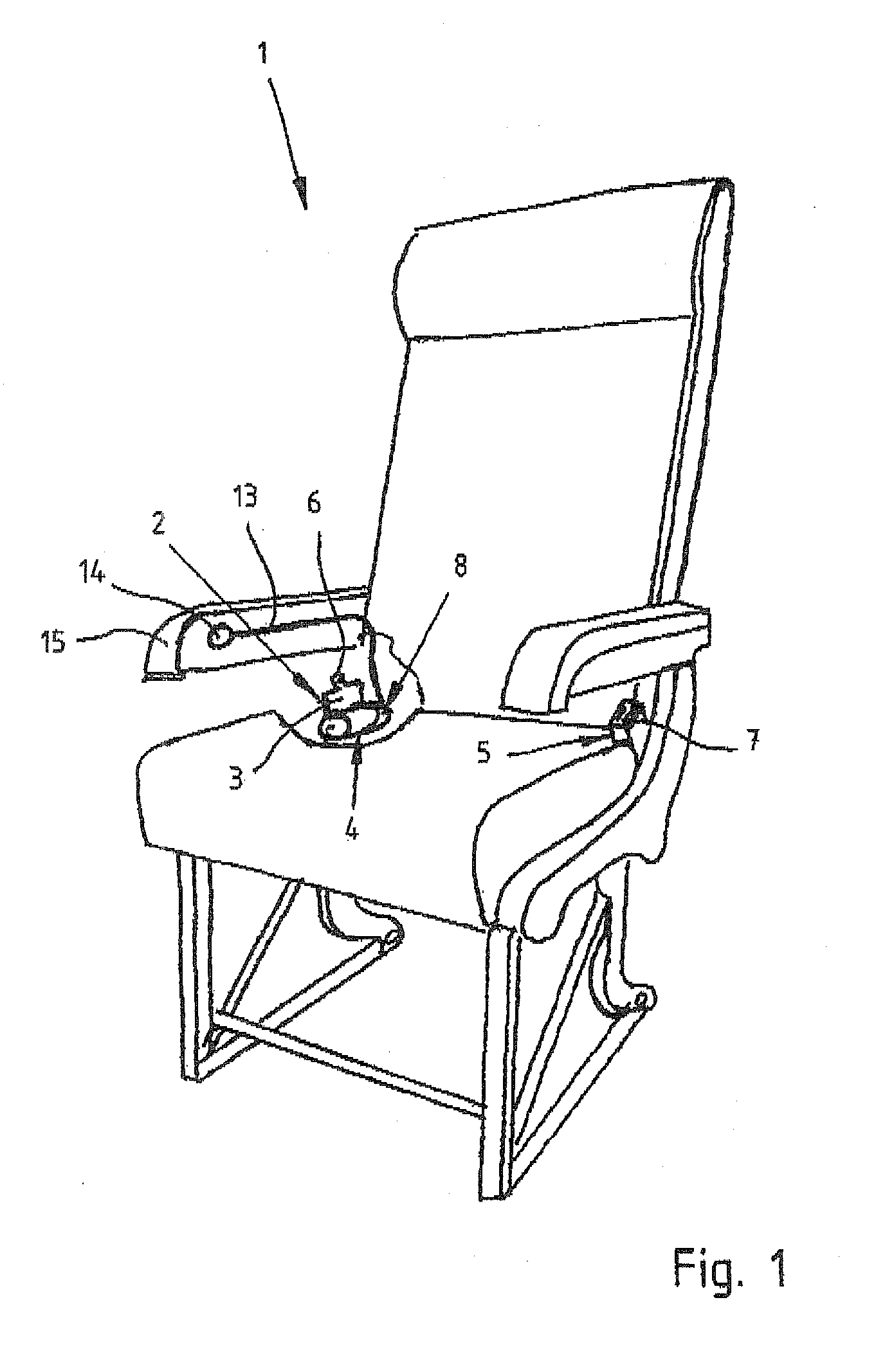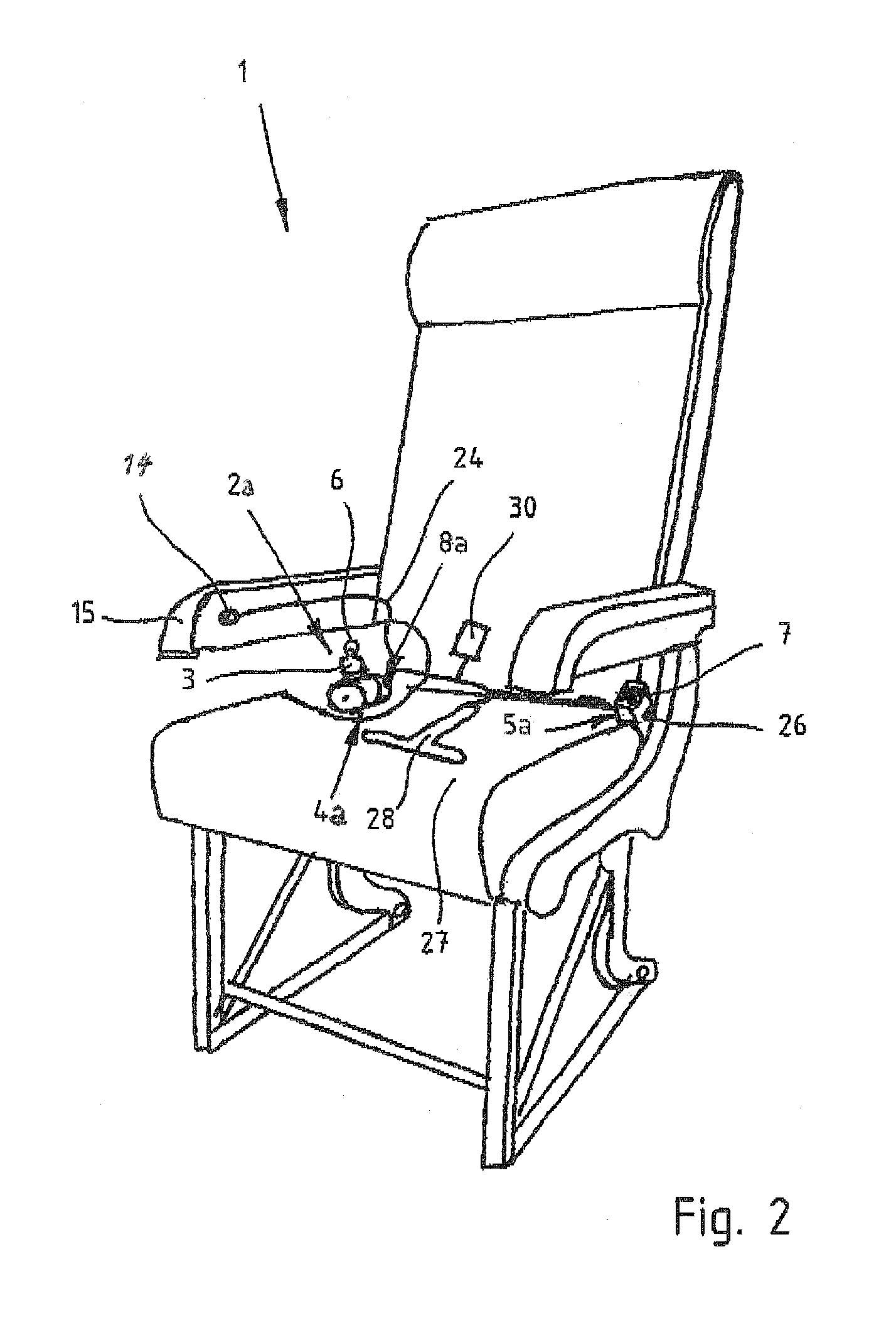[0007]The present invention resolves prior art problems by the provision of the control unit which is constructed such as to normally inhibit the belt member from being pulled out. In the normally locked position of the locking mechanism, also called pay-out barrier, the length adjuster prevents a length adjustment of the belt webbing, i.e. shortening or lengthening. In other words, the length adjuster is prevented from rotating in either of both directions. The occupant is however able to override the locking function and adjust the belt webbing to a comfortable length by making it tighter or looser. The locking function can then be reinstated either manually or automatically immediately or after a certain time period. In the ready position of the safety belt, the control unit causes the belt webbing to be fully retracted so that the seat is clear for an occupant. In other words, the belt takeup with the belt webbing is situated on one side of the seat and the buckle is situated on the other side of the seat.
[0008]When seated, the occupant activates the control unit to render the locking mechanism ineffective so that the occupant can pull out the belt webbing and insert the tongue into the buckle. The length of the belt webbing can hereby be best suited to the occupant's body for a comfortable fit, without requiring any complicated adjustments on the belt webbing. After being inserted in the buckle, the belt webbing is tightened by the length adjuster and the control unit is deactivated to render the locking mechanism effective.
[0009]Integrating the control unit in the locking mechanism allows automatic retraction of the belt webbing, when the safety belt is not in use. The seat is clear for the occupant to sit down. Activating the control unit renders the locking mechanism ineffective to enable the occupant to grab the tongue and pull out the belt webbing to guide it over the occupant's
waist and ultimately insert the tongue in the buckle. The tension force acting on the belt webbing ensures a taut fit of the belt member across the occupant's
waist, regardless of the occupant's size, and that the control unit renders the locking mechanism effective once the tongue of the belt webbing is inserted in the buckle.
[0013]In the ready position, the belt webbing of the safety belt is fully retracted by the length adjuster and the locking mechanism is rendered effective. Activating the control unit causes a rotation of the
cam disk in opposition to the recoiling force of the spring, resulting in the locking pins to radially move in the curved slots to render the locking mechanism ineffective. The belt webbing can be pulled out so long as the locking pins of the
cam disk are disengaged from the locking mechanism. When deactivating the control unit, the spring returns the
cam disk to its initial position and the locking pins engage the locking mechanism to render it effective and inhibit a lengthening of the belt webbing.
[0015]According to another advantageous feature of the present invention, the control unit may include a
magnetic switch, which is activated when the occupant actuates the
actuator to override the locking function and thus render the locking mechanism ineffective. Thus, the occupant can buckle up or adjust the length of the belt webbing. The
magnetic switch may be provided with a
timer to define a time period within which the occupant is able to override the locking function. In other words, when actuating the release button, the occupant is able to buckle up or adjust the length of the belt webbing within a predefined time period. Once the time period has elapsed, the control unit is activated and the locking mechanism is immediately rendered effective again. Using such a time window eliminates the need to press and hold the
actuator for a lengthy period, while adjusting the safety belt.
[0017]According to another advantageous feature of the present invention, a
detector may be operatively connected to the control unit to cause the control unit to implement the locking function when the
detector ascertains that the occupant occupies a vehicle seat, and to cause an overriding of the locking function, when the vehicle seat is vacated so that the length adjuster is able to retract excess belt webbing. In other words, when the seat is vacant, any slack in the belt webbing is eliminated by retracting the belt webbing. Advantageously, the control unit is deactivated within a predefined time period after the
detector has recognized that the vehicle seat is occupied to render the locking mechanism effective. Suitably, the detector may be implemented as a
pressure sensor which is integrated in a seating area of the vehicle seat.
 Login to View More
Login to View More  Login to View More
Login to View More 


